|
Immigrants came through Ellis Island ready to start a new life in a new country or to continue a career in a new country. Read on to learn more about some of the Notable Immigrants who pass through the island. Click on a name to select, or scroll down the page to see everyone. 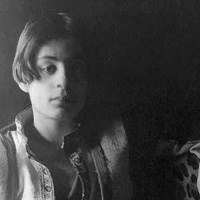
Kahlil Gibran was born in Bsharri, Lebanon (then part of the Ottoman Empire), and came to the United States through Ellis Island in 1895. After the Ottoman government convicted Gibran's father for embezzlement, they imprisoned him and confiscated all the family's property. His desperate mother felt that only by coming to America could she raise her family properly. When Gibran arrived in Boston as a young boy, he started school. He impressed his teachers with his artistic ability and soon Fred Holland Day, an artist and supporter of artists, took him under his wing. Today scholars remember Kahlil Gibran for his philosophical writings and mystical poetry. Most Americans know him through his major work The Prophet, a book of 26 poetic essays which has been translated into more than forty languages.
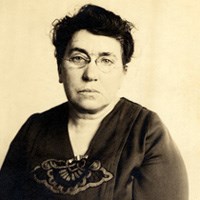
Emma Goldman, Anarchist, June 27,1869 - May 14, 1940
Emma Goldman, Anarchist June 27-1869 –May 14, 1940 Emma Goldman was born in Kovno (Yiddish for Kaunas) Czarist Russia (today Lithuania). While not an Ellis Island immigrant (she immigrated to the United States in 1885 before Ellis Island opened), Emma Goldman has the distinction of being one of the many people who were deported from the United States through Ellis Island. After leaving a failed marriage in Rochester, New York, Goldman moved to New York City in 1889. There she met Alexander Berkman. Berkman took her to hear Johann Most, editor of the radical Freiheit. Most's oratory ability and politics made an incredible impression on her. Radicalism dominated the rest of her life and she became a leading anarchist thinker, writer, and speaker. As a result of her anarchist activities and beliefs, Emma spent time in prison. In 1906 she started the journal Mother Earth. The publication acted as a venue for Goldman beliefs, including a place where radical writers could express themselves and a forum for anarchism, workers' rights, the emancipation of women and the promotion of sexual freedom. In 1917 the authorities arrested Emma Goldman and Alexander Berkman with conspiracy for inducing "persons not to register." She finished her internment in Missouri State Penitentiary in 1919, right in the middle of America's Red Scare. Shortly thereafter, she, Berkman, and other radicals were deported via Ellis Island to Russia on the steamship Buford. The press anointed the ship the "Soviet Ark." As she was leaving New York, she jotted down
She and Berkman quickly became disillusioned with the revolution.In 1921 they fled and in 1924 she published My Disillusionment in Russia, which followed the next year with My Further Disillusionment in Russia. She died in Toronto in 1940.
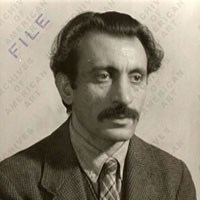
Arshile Gorky was born Vosdanig Adoian in Khorgom, Armenia. He came to the United States through Ellis Island in 1920 to join his father. He was accompanied by his 16-year old sister, Vartanouche. A contemporary of Willem de Kooning, Gorky taught at the New School of Design in Boston. Afterwards, he moved to New York City, where he became a student and later an instructor at the Grand Central School of Art. His worked ranged from portraits to abstracts and he was profoundly influenced by artists Joan Miro, Georges Braque, Paul Cezanne and, above all, Pablo Picasso.
Cary Grant, Actor, January 18, 1904 – November 29, 1986
Cary Grant was born Archibald Alexander Leach in Bristol, England and came to the United States through Ellis Island in 1920 as part of an acting troupe. When the troupe returned to England, Leach remained in the United States. Leach performed in vaudeville and several Broadway musicals before moving to Hollywood in 1931. At the urging of the studios, he changed his name to Cary Grant. Beginning with Blonde Venus in 1932, he went on to make close to 75 films, both dramas and comedies, making his final film, Walk, Don't Run in 1966. He is perhaps best remembered for his romantic comedies such as Bringing Up Baby (1938) and The Philadelphia Story (1940) and his four films with Alfred Hitchcock including Suspicion (1941) and North by Northwest (1959).
Dick Haymes, Singer, September 13, 1918 - March 28, 1980
Richard Benjamin Haymes was born in Buenos Aires, Argentina. The famous singer and entertainer entered the United States as an infant. Although Haymes intended to be a songwriter, his vocal abilities soon overshadowed his writing skills and led to a successful recording and film career. He recorded with singers such as Bing Crosby, Judy Garland, and the Andrews Sisters, including the hit, There's No Business Like Show Business. He also starred in a series of popular films in the 1940s and early 1950s. During World War II, Haymes attempted to avoid the draft by registering as a "resident alien." Born in Argentina, he had never applied for citizenship and could claim to be a citizen of a neutral country. At the same time, he was categorized as unsuitable for service due to hypertension. He was confined to the hospital on Ellis Island until his condition could be confirmed. In 1953, Haymes traveled to Hawaii, which was not yet a state. Prior to leaving, he did not notify the immigration authorities. When he attempted to return to the mainland, the government tried unsuccessfully to deport him to Argentina. The publicity from this incident helped precipitate a decline in his popularity, although he continued recording and made several television appearances until his death.
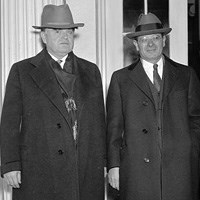
Sidney Hillman was born in a Lithuanian village in Russia and became associated with the Socialist revolutionary movement in Russia at the turn of the 20th century. Because of his activities, he was forced to flee, first to England and then to the United States in 1907. After working in the garment industry in Chicago, Hillman became involved in the movement to unionize garment workers. He served as an agent of the United Garment Workers of America and an official of the International Ladies Garment Workers Union. He was asked to be president of the Amalgamated Clothing Workers of America at their founding in 1914. He was also a founding member of the Committee for Industrial Organizing (CIO) in 1935 and the American Labor Party in 1936. Hillman's socialist leanings did not dissuade him from supporting the New Deal policies of President Franklin D. Roosevelt. Roosevelt appointed Hillman to be the associate director of the Office of Production Management and a member of the Labor Advisory Board and the National Industrial Recovery Board.
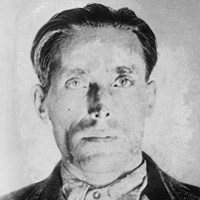
Born Joel Emmanuel Haggland in Gavle, Sweden, Haggland arrived on Ellis Island with his brother Paul in 1902. He settled in New York City, worked at menial jobs and changed his name to Joseph Hillstrom. In 1910, while residing in California, Hillstrom embraced the ideology of the International Workers of the World, a labor organization commonly referred to as the "Wobblies." The Wobblies wanted to improve the working conditions for manual laborers. Hillstrom loved music and composed many labor themed songs, including The Rebel Girl, There Is Power in a Union, We Will Sing One Song and What We Want. In January 1914, the authorities arrested Hillstrom for the murder of a grocery store operator in Salt Lake City. Based mostly upon circumstantial evidence and his own radical history, he was convicted of the crime and sentenced to death. Despite two attempts by President Woodrow Wilson to stop the execution and support from the Swedish ambassador, the Swedish public and Helen Keller, Joseph Hillstrom was executed on November 19, 1915.
Bob Hope, Actor and comedian, May 29, 1903 - July 27, 2003
Leslie Townes (Bob) Hope left England for the United States with his mother, Avis Townes Hope, and five of his brothers in 1908. They traveled third-class aboard the steamship S.S. Philadelphia and were processed at the immigration station on Ellis Island on March 30, 1908. Bob Hope's father, stonemason William Henry Hope, awaited the family in Cleveland, Ohio, In a career that lasted almost seventy years, Bob Hope made a name for himself on virtually every stage available to an entertainer. Beginning in the small-time vaudeville houses of the United States, he would ultimately find fame as a dancer, a stage actor, a radio personality, and a film and television star. In the 1920s, Bob Hope was among 20,000 vaudeville performers working in the United States.Major recognition came in 1933 courtesy of his wise-cracking part in the Broadway musical Roberta. An appearance at New York's Capitol Theater led to Bob's first radio hit, followed by a spot on the Fleishmann Hour. In May 1937, he signed a twenty-six-week radio contract with NBC. He soon left for Hollywood to film The Big Broadcast of 1938, but he continued his radio program. At Paramount Studios, Bob became a sensation in the "Road to…" pictures with Bing Crosby and Dorothy Lamour. More than fifty major films featured him and he had cameos in another fifteen.In radio, movies and television, Bob Hope was a headliner for sixty years and rose to number one in all of these media. Over a span of almost fifty years, he would also travel the world with the USO, entertaining troops from the combat zones of World War II to the dusty fields of Operation Desert Storm Bob Hope performed his first USO show in 1941. For the next fifty years, he appeared in approximately 60 USO shows, including performing for troops in World War II, Korea, Vietnam, and the 1990-1991 Persian Gulf War.In 1997, Congress declared him an "Honorary Veteran" for his service.
Mayor Vincent R. Impellitteri, Politician and Mayor of New York City, 1950-1953 February 4, 1900 - January 29, 1987
Vincent R Impellitteri, Mayor of New York City from 1950 to 1953, was born in Isnello, Italy on February 4, 1900. He and his parents came to the United States through Ellis Island when he was one year old. Impellitteri attended Fordham Law School, served in the U.S. Navy during World War I, became Assistant District Attorney of New York City in 1929, president of the New York City Council in 1946 and ultimately mayor of New York when Mayor William O'Dwyer (himself an Ellis Island Immigrant in 1910) resigned on September 1, 1950. Elected Mayor in his own right in the special election of November 1950, Impellitteri served one term. During his time in office he worked with the prominent builder, Robert Moses, on many road and public housing projects.
CLR James, Historian, January 4, 1901 - May 31,1989
Cyril Lionel Robert James was born in Trinidad and was active in the Caribbean literary movement. He wrote many short stories and his novel, Minty Alley, employed the genre of Caribbean realism, making it one of the first works of its kind. Moving to England in 1932, James became a socialist and along with other European Marxists agitated for political independence for Africa and the Caribbean. He penned his greatest work, The Black Jacobins, during this time. This book described the history of the Haitian Slave Revolt that ended in 1803 and the creation of an independent Haiti from a French colony. In 1938, James arrived in the US for a six-week lecture tour that lasted for fifteen years. Eventually, he was deported, through Ellis Island, for his radical political philosophy, although the charge simply stated that he had overstayed his visa. James ultimately returned to the US and taught at what is now the University of the District of Columbia.
Tor Johnson, Wrestler/Actor, October 19, 1903 - May 12, 1971
Karl Oscar Tore Johansson, whom associates described as a gentle giant, was born in Sweden and came to America in 1919. The ship's manifest lists Karl Erik Johansson, age 17 (b. 1902), leaving Gothenberg, Sweden aboard the S.S. Stockholm, on 30 September 1919 and arriving in NY/Ellis Island on October 11, 1919. His profession is listed as "Electrician." Tor spent most of his life as a professional wrestler. Nevertheless, he managed to act in a total of 31 movies. He was usually cast as a weightlifter or strongman. Although Johnson played brutish characters in films such as Bride of the Monster (1955), Plane 9 from Outer Space (1959) and Night of the Ghouls (1959), costars commented on his warm and friendly personality.
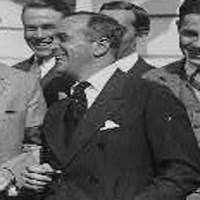
Al Jolson was born Asa Yoelson in Sredink, Lithuania, then part of the Russian Empire. He entered the United States as a child in 1894, passing through Ellis Island with his mother and three siblings. They joined his father, a rabbi and cantor, who had come to New York three years earlier. Jolson became a singer, actor, and comedian starring in vaudeville, on Broadway, and eventually in films and radio. By the 1930s, he was the best known and highest paid performer in the United States. He is often credited with introducing jazz, ragtime, and blues to a broad white audience. Jolson's career is perhaps most remembered for his starring role in the first feature-length movie with synchronized sound (aka the "Talkie"), 1927's The Jazz Singer where he sings Toot, Toot Tootsie, Blue Skies and Mammy. His career continued with pictures such as The Singing Fool (1928), Big Boy (1930), Rhapsody in Blue (1945) and The Jolson Story (1946). During World War II and the Korean War, Jolson performed abroad for the troops. He died after returning from a particularly exhausting tour in 1950.
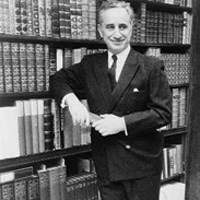
Elias Kazan was born Elias Kazanjoglou to Greek parents in Constantinople, Ottoman Empire (now Istanbul, Turkey). His parents emigrated to the United States in 1913, when Kazan was four years old. Later in life, Kazan explored his own immigrant roots in his autobiography Elia Kazan: A Life (1988) and in his 1961 book and 1963 film America, America. After studying at Williams College and Yale Drama School, Kazan joined the Group Theater in New York, among whose members were Lee Strasberg and Clifford Odets. The Group Theater was dedicated to plays that introduced social commentary to the stage. Kazan became one of the Group's most accomplished actors and directors and one of New York's most successful stage directors. In 1947, Kazan co-founded the Actors Studio. This nonprofit organization became one of the preeminent training programs for actors and introduced "method acting" to the American stage. This type of acting emphasizes the actor's immersion into the character being portrayed. The actor draws upon his or her own emotions and memories for the interpretation of a character. Kazan moved into feature filmmaking in 1945 with A Tree Grows in Brooklyn. Like his work on the stage, his films addressed issues of contemporary concern. In 1947, he made Gentleman's Agreement, a film that exposed the subtle anti-Semitism of the era. He followed Gentleman's Agreement with Pinky (1949), which explored racial prejudice against African Americans.In the 1950s, he directed two films that are recognized by many as two of the greatest films ever made -- A Streetcar Named Desire (1951) and On the Waterfront (1954). In 1952, Kazan testified as a friendly witness before the House Un-American Activities Committee of the United States House of Representatives, which was investigating communist activities in the film and theater business. Many of Kazan's left-leaning and liberal friends and associates resented him for this. When he was 90 years old, he was awarded an honorary Oscar for lifetime achievement. Some members of the audience refused to applaud.
John Kluge, Businessman, September 21, 1914 - September 7, 2010
John Werner Kluge was born Johannes Werner Kluge in Chemnitz, Germany. His father was killed in World War I and his mother remarried German-American Oswald Leitert. Johannes, his mother Gertrude, and his step-father Oswald sailed as steerage passengers in 1922 aboard the S.S. George Washington to the United States, arriving at Ellis Island on September 15. Kluge was the founder of Metromedia, a media conglomerate that included television stations, radio stations, mobile phones, and live entertainment. He was an astute businessman known for seizing opportunity in risky or overlooked ventures. At one time one of the richest men in the United States, Kluge also became a great philanthropist. His vast wealth allowed him to bestow financial gifts to various institutions. He donated $60 million to what was to become the John W. Kluge Center at the Library of Congress and $510 million to Columbia University. He also contributed to the restoration of Ellis Island.
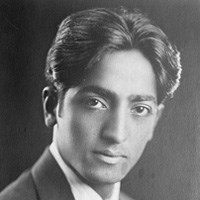
Jiddu Krishnamurti was born in colonial India and entered the United States through California in 1922. He was briefly detained on Ellis Island on August 22, 1926, during a later visit, so authorities could investigate an accusation of "moral turpitude," a legal concept involving behavior that contradict accepted moral standards. Krishnamurti devoted his life to seeking truth and felt that the search for it did not follow any one path, religion or person. He did not consider himself as belonging to any country or religion and emphasized the universality of humanity. A person could only undergo transformation through their ever-deepening awareness. Among the books he authored are The First and Last Freedom, The Only Revolution, and Krishnamurti's Notebook.
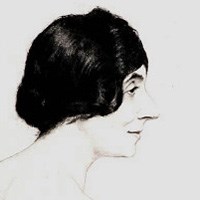
Wanda Landowska was born to a privileged Jewish family in Warsaw, Poland (then part of Czarist Russia). Her father was a lawyer and her mother was a linguist. At the age of four she started to learn the piano. She studied at the Warsaw Conservancy and learned composition under the guidance of teachers in Berlin and Paris. In 1925 Landowska established the Ecole de Musique Ancienne in Paris.Her home became known as a gathering place for both the performing and studying of old music. Landowska played a major part in reviving the popularity of the harpsichord. After the Germans invaded France, she could no longer remain. She sailed from Lisbon, Portugal on November 28, 1941 on the S.S. Exeter and arrived at Ellis Island on December 8, 1941. She was briefly detained on Ellis Island as a war refugee. Once in America, she continued as a performer and teacher. Landowska died in Lakeville, Connecticut on August 16, 1959 at the age of eighty.
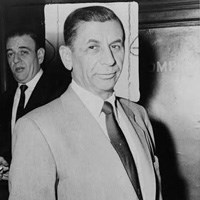
Meyer Lansky was born Meyer Suchowljansky in Grodno, Czarist Russia (now Belarus). Lansky left the port of Libau on March 21, 1911 with his mother and brother and sailed on the steamship S.S. Kursk for the United States. They landed on Ellis Island on April 4, 1911. The family joined Meyer's father, who had emigrated a few years earlier, at 3-5 Lewis Street on the Lower East Side. Meyer Lansky, along with fellow gangsters Bugsy Siegel and Lucky Luciano, formed a crime syndicate that controlled bootlegging and gambling throughout the United States and beyond for decades. Lansky and Siegel had befriended each other as teenagers. During Prohibition they and Luciano, formed an organized gang that specialized in bootlegging and the protection rackets. Lansky would go on to be a key player in a loose association of organized criminal gangs, including the Italian Mafia and Jewish criminal organizations. For years people considered him to be one of the most dangerous and powerful people in the United States. Upon learning in 1970 that he was going to be arrested for income tax evasion, he fled to Israel. He was arrested and returned to the United States, but in 1973 he was acquitted of income tax evasion and other charges. Lansky died of lung cancer on January 15, 1983 in his home in Miami Beach. Officially he owned almost nothing. The FBI, and others, however, thought he had millions stashed away in hidden bank accounts, although family and biographers denied this.
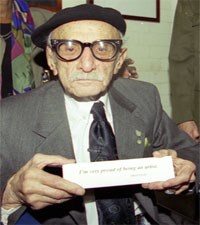
Alfred (Abraham) Levitt came to the United States from the village of Starodub in Russia in 1911. By time time of his death at the age of 105, his paintings were in the New York's Metropolitan Museum of Art, as well as other major museums. In his early years in New York he worked as a model and attended art classes at the Ferrer School in Manhattan. Later, he continued his education at the Art Students League. During this period, Levitt became part of a growing New York art community that included Marcel Duchamp, Robert Henri, Mark Rothko, Georgia O'Keefe, and Margaret Sutton. (Sutton lived with him and his wife for fifty years.) Among the artists that greatly influenced his work were Robert Henri (whose Realist style he emulated) and Hans Hofmann (who introduced him to European cubism). In the 1940's, Levitt spent summers in Gloucester, Massachusetts where he produced some of his best-known work. Levitt's interests also extended to the prehistoric cave paintings in such sites as Lascaux, France. His studies of these sites were rewarded with a Chevalier of the Order of the Arts and Letters bestowed upon him by France.
Bela Lugosi, Actor, October 20, 1882- August 16, 1956
Bela Lugosi was born Béla Ferenc Dezsö Blaskó in Lugos, Austria-Hungary (now Lugoj, Romania). Lugosi entered the United States through the port of New Orleans in 1920.He traveled to New York City where he presented himself to the authorities at Ellis Island in 1921. He passed inspection and the immigrant authorities allowed him to remain in the country. He eventually became a naturalized citizen of the United States of America. Before coming to the United States, Lugosi performed as a member of Budapest's National Theater and made films in Hungary and Germany.In America, Lugosi acted in small theatrical productions until 1927, when he appeared in the role of the vampire in the Broadway play Dracula. The success of the play prompted an invitation from Hollywood to reprise his role in the 1931 film - the role for which he has become a household name. After the success of Dracula, although the studios typecast Lugosi as the personification of evil, he left his mark in film history with great roles in movies such as Murders in the Rue Morgue (1932), White Zombie (1932), Island of Lost Souls (1933), The Black Cat (1934), Mark of the Vampire (1935), Son of Frankenstein (1939) and Abbott and Costello Meet Frankenstein (1948). Over the course of his career in Europe and in the United States, Bela Lugosi appeared in over twenty-five silent films, in over sixty sound films, and on the stage over two hundred times. The immigrant from Hungary has become an icon for his portrayal as Dracula and has secured a place in America's history.
[Back to Index] [Notable Immigrants A-F] [Notable Immigrants M-Z]
|
Last updated: October 19, 2021
